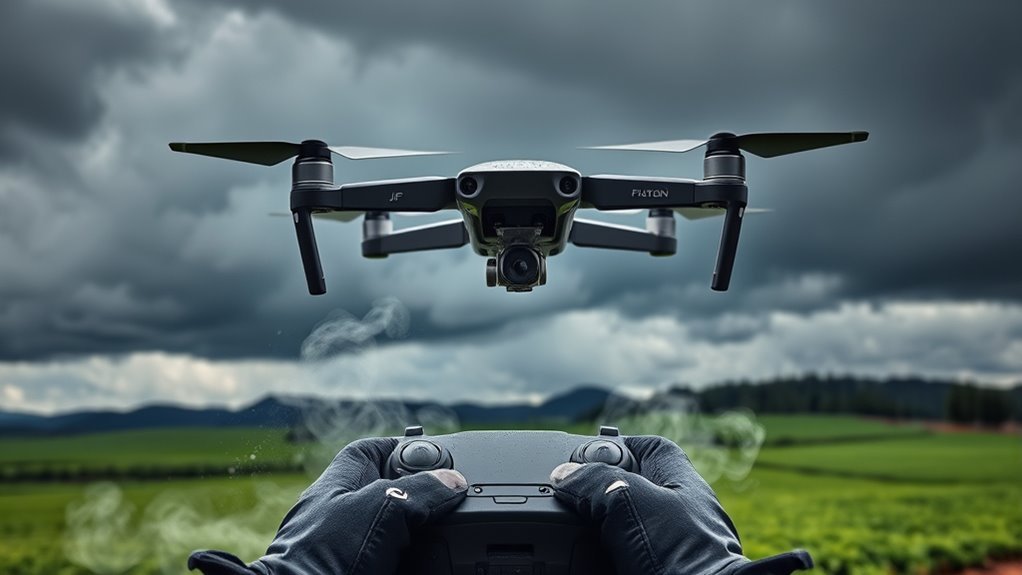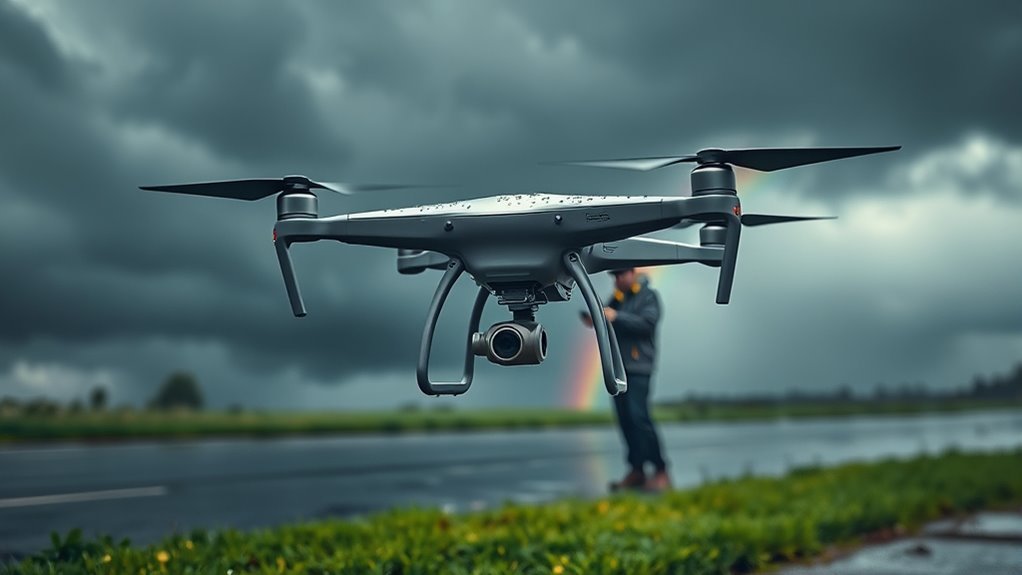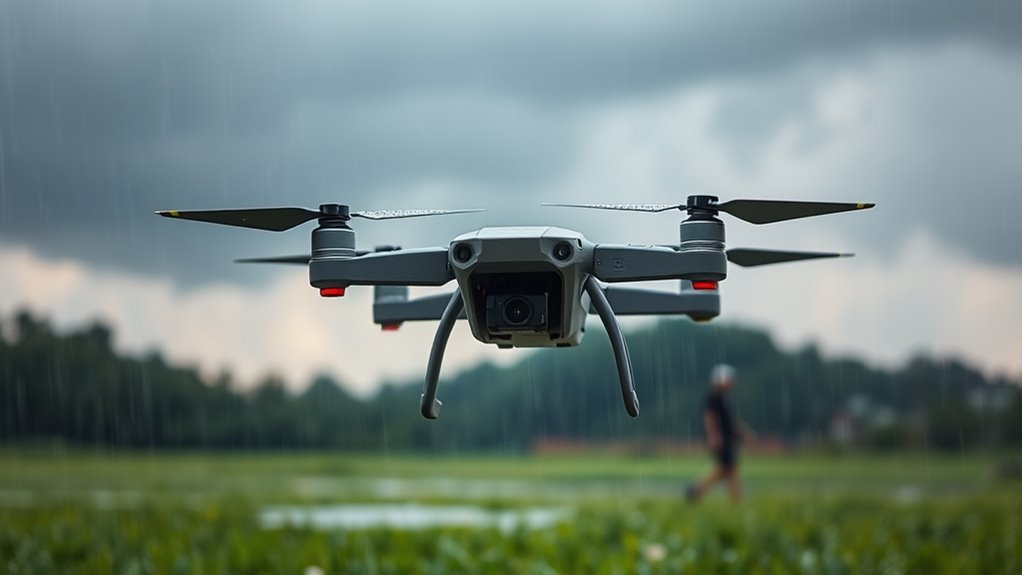To safely fly your drone in the rain, first check its weather resistance features, like IP ratings. Inspect waterproof seals, battery, and propellers for moisture. Use rain gear for your remote controller and keep your drone within sight. Fly at a lower altitude to manage control in winds. After flight, dry your drone completely, remove the battery, and check for water damage. These steps guarantee a safe flying experience in wet conditions, and there’s more to explore on post-flight maintenance.
Understanding Your Drone’s Weather Resistance

When it comes to flying your drone in the rain, understanding its weather resistance is essential. Start by checking your drone specifications, as not all models are built to withstand wet conditions. Look for weather ratings, such as IP ratings, which indicate the level of protection against moisture and dust. An IP rating of 67, for example, means your drone can handle brief submersion and is generally safe for light rain. If your drone lacks these ratings, it’s best to avoid flying in wet weather, as moisture can damage internal components. Knowing your drone’s capabilities allows you to make informed choices, ensuring you enjoy the freedom of flight while minimizing risks associated with unpredictable weather. Moreover, it’s crucial to recognize that established brands, like Parrot’s expertise, often provide drones with better weather resistance due to years of innovation in the industry. Additionally, market dynamics can influence the availability of drones with improved weather capabilities, as brands adapt to evolving consumer demands in the face of competition.
Essential Pre-Flight Checks for Rainy Conditions

Before you take to the skies, it’s important to conduct thorough pre-flight checks, especially in rainy conditions. Start by inspecting your drone’s waterproofing features; verify that all seals and ports are secure to prevent water damage. Next, check the battery and propellers for any signs of wear or moisture. It’s also vital to confirm that your remote controller is protected; consider using rain gear specifically designed for electronics. Double-check that your flight area is clear of obstacles and that visibility is adequate. Finally, make sure your drone’s firmware is up to date, as this can enhance its performance in challenging weather. With these checks complete, you’ll be better prepared to enjoy your flight, rain or shine.
Techniques for Safe Drone Operation in Rain

With your drone thoroughly checked and ready for flight, it’s important to adopt specific techniques for safe operation in rainy conditions. First, make sure your drone features effective drone waterproofing, which can help prevent damage from moisture. Next, familiarize yourself with rain flight regulations in your area, as they might differ from standard flying rules. When flying, maintain a lower altitude to reduce the risk of losing control in strong winds, and always keep your drone within visual line of sight. Use gentle control inputs to avoid abrupt movements that can lead to instability. Finally, monitor weather updates closely; if conditions worsen, it’s safer to land and wait for a clearer sky. Prioritize safety to enjoy your flying experience.
Capturing Stunning Aerial Shots in Wet Weather
Although flying a drone in wet weather poses challenges, it can also yield breathtaking aerial shots that showcase landscapes in a unique way. To make the most of your rainy day photography, follow some essential aerial photography tips. First, capture the vibrant colors that often pop against gray skies; overcast conditions can create stunning contrasts. Use rain photography techniques to your advantage by shooting from lower altitudes for a different perspective. Water droplets on your lens can add an artistic touch, so don’t hesitate to experiment. Also, consider adjusting your camera settings to accommodate lower light levels, ensuring your images remain sharp and well-exposed. Embrace the freedom that comes with capturing nature’s beauty in its raw, wet form.
Post-Flight Maintenance Tips for Rain-Drenched Drones
Once you’ve landed your drone after a flight in the rain, it is crucial to conduct proper post-flight maintenance to guarantee its longevity and peak performance. Start by ensuring your drone is completely dry. Here are some tips for effective drone drying:
- Remove the battery and let it dry separately.
- Use soft cloths to wipe down all surfaces.
- Check moisture sensors to assess internal humidity.
- Allow your drone to air-dry in a warm, dry place for at least 24 hours.
- Inspect components for water damage or corrosion.
Frequently Asked Questions
Can I Fly My Drone During a Thunderstorm?
You shouldn’t fly your drone during a thunderstorm. Thunderstorm safety is essential, and drone precautions are necessary. Lightning poses severe dangers, and wet conditions can damage your equipment, risking both your drone and personal safety.
What Should I Do if My Drone Gets Wet?
If your drone gets wet, immediately power it down. Remove the battery and dry it gently. Verify proper drone maintenance by checking for water resistance. Let it air dry thoroughly before attempting to fly again.
Are There Specific Drones Designed for Heavy Rain?
If you’re venturing into the stormy skies, consider waterproof drones designed for heavy rain. Their durability guarantees they withstand the elements, giving you the freedom to capture stunning footage even in challenging conditions.
How to Protect My Drone’s Camera in Rain?
To protect your drone’s camera in the rain, use camera covers and moisture barriers. These accessories shield your equipment from water damage, ensuring you capture clear images while enjoying the freedom of flying in wet conditions.
Is Flying in Fog Similar to Flying in Rain?
Flying in fog isn’t quite like flying in rain. Fog can reduce visibility considerably, impacting your drone’s sensors. Both conditions pose risks, but fog often complicates navigation more than rain, so caution’s essential.

